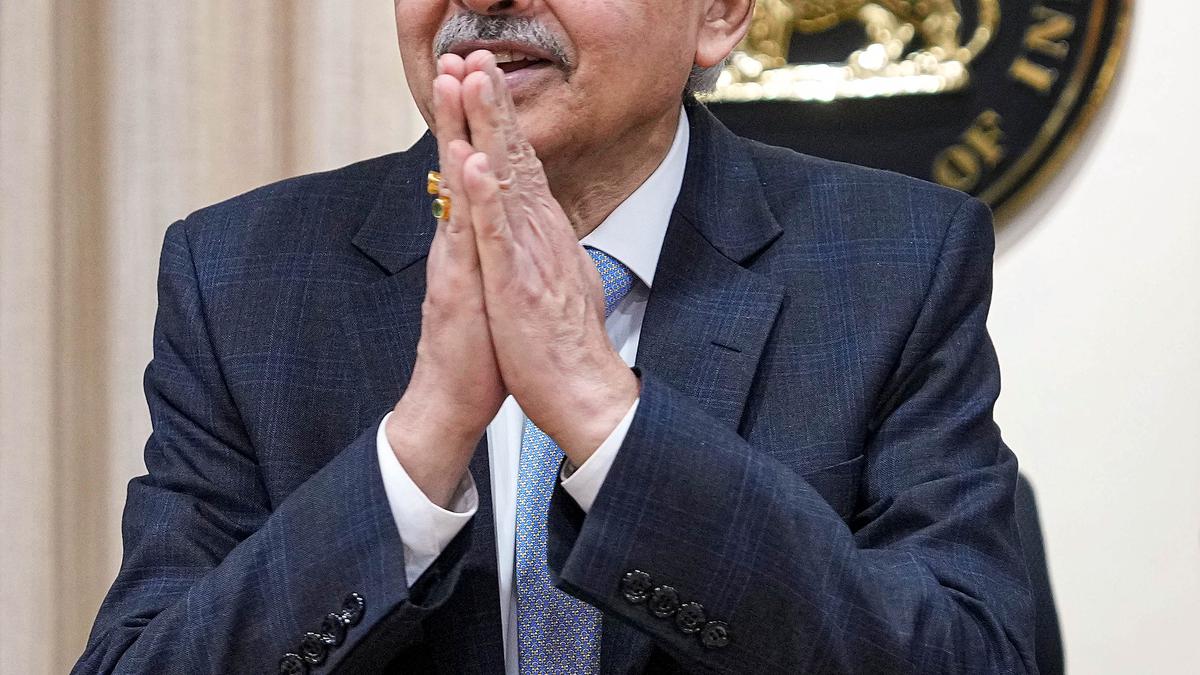Mumbai: Reserve Bank of India (RBI) Governor Shaktikanta Das arrives to address a press conference on monetary policy statement, at the RBI headquarters, in Mumbai, Friday, Dec. 8, 2023.
| Photo Credit: PTI
“To expect the unexpected shows a modern intellect,” is an oft-quoted line from playwright Oscar Wilde. For even the smartest minds, the Reserve Bank of India’s bold call to revise India’s GDP growth target to 7% in FY24–from 6.5% earlier–seemed unexpected yet spirited. A closer scrutiny shows that it comes from a renewed optimism that its year-long efforts to contain inflation are yielding results as well as that economic growth is gaining momentum with green shoots appearing in more supporting segments.
For the record, the status quo in key policy rates was expected as per the consensus. The inflation number in October–dipping below 5%–had come closer to the RBI target of 4% after a 250-basis points hike. This is largely due to food inflation moderating to 6.2% in October owing to vegetable prices correcting and fuel inflation slipping due to the reduction in LPG prices in August. Coupled with the steady effect of the policy rate hikes, the disinflation in core inflation quickly turned beneficial. Even though consumer price inflation (CPI) may go up to 5.6% in Q3 and 5.2% in Q4, it is not expected to disturb the inflation target for FY24 at 5.4%.
However, the courageous call of 7% comes–not just from the 7.6% Q2 performance, propelled by strong investment and government consumption, but from emerging and encouraging underlying factors. Demand conditions are robust; rural consumption is improving as seen from higher sales of FMCG goods while the urban consumer is holding up the economy. Automobile sales hit a new peak in November despite high interest rates, with high-end vehicles getting a good preference.
Manufacturing sector has improved on easing input cost pressures, adding more employment while the services sector is remaining strong and expanding rapidly. GST collections also show a healthy trend. Investment activity has gathered pace with due support from the public sector capex; sectors like steel and cement will also trigger growth in a hitherto-subdued commercial vehicles and construction equipment. Overall, capacity utilisation has gone up even as private companies started investing in fixed assets. From the financing perspective, banks have funded the commercial sector to the extent of ₹17.6 lakh crore so far in FY24 as against ₹14.5 lakh crore last fiscal. Exports of goods and services also continue to be positive amid global economic uncertainties.
There are many more positives; strong private consumption, continued buoyancy in services, healthy ‘twin balance sheets” of banks and corporates, high capacity utilisation and the government’s renewed spending on infra would lead to growth. To its comfort, autonomous factors such as higher currency leakage during the festive season, government cash balances and open market operations have helped the central bank maintain systemic liquidity in its comfort zone. We expect the liquidity to stay minimal or negative as the RBI is now keen to reduce a bloated balance sheet, used for the COVID-19 stimuli. Such resilience in core pillars of the economy must be enough to go slow on further rate hikes.
However, inflation, especially from crude and global commodity prices, prolonged geo-political issues and financial volatility can certainly mar this goal, impacting balance of payments, rupee and stock markets. The U.S. Fed remains the singular element to exert undue influence on the RBI’s calculations. Domestically, that credit goes to food prices.
The RBI’s hawkish stance is understandable for the dangers ahead. Food inflation remains a threat to its calculations–be it weather or supply related. At the moment, all eyes are on the data from Kharif crop and rabi sowing. Elevated sugar prices across the world have already forced the Government to ban diversion of sugarcane juice to ethanol production. Some of the pulses will continue to be in shortage, forcing import in large scale.
Overall, high frequency indicators are pointing to a spike in prices of key vegetables which may push consumer inflation in the next two quarters. But then, as the Governor said, it would be nothing like the ‘summer of 2022’–an assurance which underlines that most of it is manageable.
(The author is Group President and Head – Consumer Bank, Kotak Mahindra Bank Ltd.)




)


